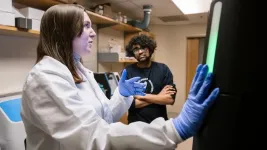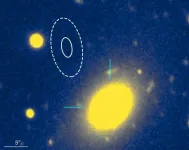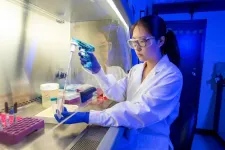(Press-News.org) AURORA, Colo. (Jan. 22, 2025) – A breakthrough study published today in the Journal of Neuroscience sheds new light on how brain cells relay critical information from their extremities to their nucleus, leading to the activation of genes essential for learning and memory.
Researchers have identified a key pathway that links how neurons send signals to each other, or synaptic activity, to the expression of genes necessary for long-term changes in the brain, providing crucial insights into the molecular processes underlying memory formation.
“These findings illuminate a critical mechanism that connects local synaptic activity to the broader gene expression changes necessary for learning and memory,” said Mark Dell’Acqua, professor of pharmacology at the University of Colorado Anschutz Medical Campus and senior author of the study. “This paper is mainly a basic science finding of a fundamental process of what nerve cells do. Understanding this relay system not only enhances our knowledge of brain function but could also better inform therapeutic treatments for cognitive disorders.”
The nucleus where the genes that modify neuron function are controlled is a long distance away from where neurons receive input from their synapses, which are located in distant dendrites that extend like branches from the trunk of a tree. This research focuses on the cAMP-response element binding protein (CREB), a transcription factor known to regulate genes vital for dynamic changes at synapses which is essential for neuronal communication. Despite CREB’s well-documented role in supporting learning and memory, the exact mechanisms leading to CREB activation during neuronal activity remain unclear.
Using advanced microscopy techniques, graduate student Katlin Zent in Dr. Dell’Acqua’s research group revealed a crucial relay mechanism involving the activation of receptors and ion channels generating calcium signals that rapidly communicates from synapses in remote dendrite branches to the nucleus in the neuron cell body.
“Going forward, this research will enable us to better examine the way these pathways are utilized in different disease states,” said Dell’Acqua. “We could see exactly what parts of this new mechanism are interfered with and where, giving us a better idea of how this pathway affecting learning and memory is impacted. This research highlights potential targets for interventions aimed at conditions like Alzheimer’s disease and other memory-related disorders.”
About the University of Colorado Anschutz Medical Campus
The University of Colorado Anschutz Medical Campus is a world-class medical destination at the forefront of transformative science, medicine, education and patient care. The campus encompasses the University of Colorado health professional schools, more than 60 centers and institutes and two nationally ranked independent hospitals - UCHealth University of Colorado Hospital and Children's Hospital Colorado – which see more than two million adult and pediatric patient visits yearly. Innovative, interconnected and highly collaborative, the CU Anschutz Medical Campus delivers life-changing treatments, patient care and professional training and conducts world-renowned research fueled by $910 million in annual research funding, including $757 million in sponsored awards and $153 million in philanthropic gifts.
END
New study uncovers key mechanism behind learning and memory
This study demonstrates how long-distance communication in neurons works in the brain, which is key to sustaining the brain’s plasticity and adaptability
2025-01-21
ELSE PRESS RELEASES FROM THIS DATE:
Seeing the unseen: New method reveals ’hyperaccessible’ window in freshly replicated DNA
2025-01-21
San Francisco—January 21, 2025—DNA replication is happening continuously throughout the body, as many as trillions of times per day. Whenever a cell divides—whether to repair damaged tissue, replace old cells, or simply to help the body grow—DNA is copied to ensure the new cells carry the same genetic instructions.
But this fundamental aspect of human biology has been poorly understood, chiefly because scientists lack the ability to closely observe the intricate process of replication. Attempts to do so have relied on chemicals that damage the DNA structure or strategies ...
Extreme climate pushed thousands of lakes in West Greenland ‘across a tipping point,’ study finds
2025-01-21
West Greenland is home to tens of thousands of blue lakes that provide residents drinking water and sequester carbon from the atmosphere. Yet after two months of record heat and precipitation in fall 2022, an estimated 7,500 lakes turned brown, began emitting carbon and decreased in water quality, according to a new study.
Led by Fulbright Distinguished Arctic Scholar and University of Maine Climate Change Institute Associate Director Jasmine Saros, a team of researchers found that the combination of extreme climate events in fall 2022 caused ecological change that ...
Illuminating an asymmetric gap in a topological antiferromagnet
2025-01-21
Topological insulators (TIs) are among the hottest topics in condensed matter physics today. They’re a bit strange: their surfaces conduct electricity, yet their interiors do not, instead acting as insulators. Physicists consider TIs the materials of the future because they host fascinating new quantum phases of matter and have promising technological applications in electronics and quantum computing. Scientists are just now beginning to uncover connections between TIs and magnetism that could unlock new uses for these exotic materials.
A ...
Global public health collaboration benefits Americans, SHEA urges continued support of the World Health Organization
2025-01-21
The Society for Healthcare Epidemiology of America (SHEA) wants to emphasize the importance of global partnerships in addressing health threats that impact all of us, as Americans and global citizens. We urge President Trump to reconsider the decision to terminate the U.S. relationship with the World Health Organization (WHO). The most effective way to address emerging health threats is through collaborative efforts with international partners. Eliminating U.S. involvement in the WHO would leave our country—and the world—more vulnerable to infectious diseases and less prepared to manage pandemics, fight emerging health threats, ...
Astronomers thought they understood fast radio bursts. A recent one calls that into question.
2025-01-21
Astronomer Calvin Leung was excited last summer to crunch data from a newly commissioned radio telescope to precisely pinpoint the origin of repeated bursts of intense radio waves — so-called fast radio bursts (FRBs) — emanating from somewhere in the northern constellation Ursa Minor.
Leung, a Miller Postdoctoral Fellowship recipient at the University of California, Berkeley, hopes eventually to understand the origins of these mysterious bursts and use them as probes to trace the large-scale structure of the universe, a key to its origin and evolution. He had written most of the computer code that allowed ...
AAAS announces addition of Journal of EMDR Practice and Research to Science Partner Journal program
2025-01-21
Journal of EMDR Practice and Research (JEMDR), launched in 2007, is devoted to integrative, state-of-the-art papers about EMDR therapy. It is a broadly conceived interdisciplinary journal that stimulates and communicates research and theory about EMDR therapy and its application to clinical practice. The journal publishes articles on all aspects of EMDR therapy and Adaptive Information Processing (AIP) theory. JEMDR is co-lead by Jenny Ann Rydberg, MA, PhdD cand. (University of Lorraine, Nancy, France) and Derek Farrell, PhD, MBE (Northumbria, Newcastle-upon-Tyne, UK).
As a member of the Science Partner Journal program, JEMDR will publish on a continuous basis under ...
Study of deadly dog cancer reveals new clues for improved treatment
2025-01-21
Researchers at the University of Florida College of Veterinary Medicine and the UF Health Cancer Center have identified a crucial link between a gene mutation and immune system signaling in canine hemangiosarcoma, a discovery that could lead to better treatments for both dogs and humans with similar cancers.
The research focuses on hemangiosarcoma, an aggressive cancer that forms malignant blood vessels in dogs. This life-threatening condition is difficult to diagnose early, as tumors can grow silently before rupturing without warning, leading to emergencies. ...
Skin-penetrating nematodes have a love-hate relationship with carbon dioxide
2025-01-21
Key takeaways
Globally, over 600 million people are infected with the skin-penetrating threadworm, Strongyloides stercoralis, mostly in tropical and subtropical regions with poor sanitation infrastructure.
Infections are treated with ivermectin, but some nematodes are starting to develop resistance to this first-line drug.
UCLA biologists have discovered that the nematodes respond differently to carbon dioxide at different stages in their life cycle, which could help scientists find ways to prevent or cure infections by targeting ...
Fewer than 1% of U.S. clinical drug trials enroll pregnant participants, study finds
2025-01-21
PROVIDENCE, R.I. [Brown University] — A new study by researchers from the Brown University School of Public Health found that pregnant women are regularly excluded from clinical drug trials that test for safety, raising concerns for the efficacy of these medications for maternal and child health.
The study, published in the American Journal of Obstetrics and Gynecology, analyzed 90,860 drug trials involving women ages 18 to 45 from the past 15 years and found that only 0.8% included pregnant participants. ...
A global majority trusts scientists, wants them to have greater role in policymaking, study finds
2025-01-21
In what is considered the most comprehensive post-pandemic survey of trust in scientists, researchers have found a majority of people around the world carry widespread trust in scientists — believing them to be honest, competent, qualified and concerned with public well-being.
Researchers surveyed more than 72,000 individuals across 68 countries on perceptions of scientists’ trustworthiness, competence, openness and research priorities.
The results, published in the journal Nature Human Behavior, also showed the general public’s desire ...
LAST 30 PRESS RELEASES:
How human interaction drove evolution to make bears less aggressive
National Poll: Few parents offer teens guidance on healthy eating during holiday season
Cannabis derivatives could provide new ovarian cancer treatments
Raising strong yeast as a petroleum substitute
Clues to the origin of hot Jupiters hidden in their orbits
Canada’s reduced pledge to Global Fund will impact domestic health
1 in 4 children with major traumatic injuries not cared for in pediatric trauma centres
Duke and Duke-NUS’ joint cross-population research to uncover "East-West" differences in disease and care
Scientists to ‘spy’ on cancer- immune cell interactions using quantum technology breakthrough
Tech savvy users have most digital concerns
Making lighter work of calculating fluid and heat flow
Normalizing blood sugar can halve heart attack risk
Lowering blood sugar cuts heart attack risk in people with prediabetes
Study links genetic variants to risk of blinding eye disease in premature infants
Non-opioid ‘pain sponge’ therapy halts cartilage degeneration and relieves chronic pain
AI can pick up cultural values by mimicking how kids learn
China’s ecological redlines offer fast track to 30 x 30 global conservation goal
Invisible indoor threats: emerging household contaminants and their growing risks to human health
Adding antibody treatment to chemo boosts outcomes for children with rare cancer
Germline pathogenic variants among women without a history of breast cancer
Tanning beds triple melanoma risk, potentially causing broad DNA damage
Unique bond identified as key to viral infection speed
Indoor tanning makes youthful skin much older on a genetic level
Mouse model sheds new light on the causes and potential solutions to human GI problems linked to muscular dystrophy
The Journal of Nuclear Medicine ahead-of-print tip sheet: December 12, 2025
Smarter tools for peering into the microscopic world
Applications open for funding to conduct research in the Kinsey Institute archives
Global measure underestimates the severity of food insecurity
Child survivors of critical illness are missing out on timely follow up care
Risk-based vs annual breast cancer screening / the WISDOM randomized clinical trial
[Press-News.org] New study uncovers key mechanism behind learning and memoryThis study demonstrates how long-distance communication in neurons works in the brain, which is key to sustaining the brain’s plasticity and adaptability




